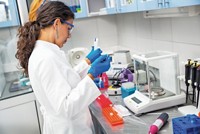Advertisement
Grab your lab coat. Let's get started
Welcome!
Welcome!
Create an account below to get 6 C&EN articles per month, receive newsletters and more - all free.
It seems this is your first time logging in online. Please enter the following information to continue.
As an ACS member you automatically get access to this site. All we need is few more details to create your reading experience.
Not you? Sign in with a different account.
Not you? Sign in with a different account.
ERROR 1
ERROR 1
ERROR 2
ERROR 2
ERROR 2
ERROR 2
ERROR 2
Password and Confirm password must match.
If you have an ACS member number, please enter it here so we can link this account to your membership. (optional)
ERROR 2
ACS values your privacy. By submitting your information, you are gaining access to C&EN and subscribing to our weekly newsletter. We use the information you provide to make your reading experience better, and we will never sell your data to third party members.
Business
Radiochemicals: Down But Not Out
After two big departures, business is good for remaining players
by Michael McCoy
April 5, 2010
| A version of this story appeared in
Volume 88, Issue 14

The first sign that all may not be right in the radiochemicals business appeared in July 2008, when Sigma-Aldrich announced that it would leave the field that September. The research products giant told customers that carbon-14- and tritium-labeled compounds were on the decline, being replaced by “newer and less hazardous” technologies such as fluorescent and stable isotope labeling.
Then in December 2008, General Electric informed customers that it would exit radiochemicals by the end of 2009. Six months later, GE sold the custom synthesis side of the business to Quotient Bioresearch, a U.K.-based provider of drug development services. In September 2009, GE announced that PerkinElmer had acquired its radiochemical catalog business, along with two related product lines.
A business abandoned by two major companies in the past two years can’t be a great one. Still, remaining players insist there’s life left in the market for these research tools. They say nothing’s better for the tracking of pharmaceuticals and other compounds as they work their way through living things.
As the name implies, radiochemicals are chemicals in which one or more atoms have been replaced with a radioactive isotope. Some radiochemicals incorporate short-lived isotopes such as phosphorus-32 and iodine-125. More common are compounds tagged with the long-lived isotopes carbon-14 and hydrogen-3, better known as tritium.
The formative event in the development of the U.S. radiochemicals business was the 1956 launch of New England Nuclear (NEN), a Boston-based supplier of radioactive chemicals for use in scientific research.
How Radiolabeled Compounds Are Made
Inserting tritium into an organic molecule is relatively simple, says J. Richard Heys, who retired in 2005 after a long career in radiochemistry with AstraZeneca and GlaxoSmithKline. With two colleagues, Heys recently wrote a book called “Preparation of Compounds Labeled with Tritium and Carbon-14” (2009, John Wiley & Sons).
As Heys explains, hydrogen atoms in many organic compounds will switch places with tritium under the influence of appropriate catalysts. Whereas tritium-labeled compounds are usually preferred in brain and epigenetics research, carbon-14-based compounds are more appropriate for use in studies of a drug’s absorption, distribution, metabolism, and excretion.
The world’s largest supplier of carbon-14 is Reviss Services, a U.K.-based firm that is the main distributor of isotopes from state-owned nuclear facilities in Russia. Reviss markets carbon-14 in the form of barium carbonate, which is the starting material for all other carbon-14-labeled compounds, Heys says.
Chemists have multiple techniques for creating [14C]radiochemicals, but a common one is to release carbon dioxide from barium carbonate, then react the 14CO2 with an appropriate strong anion to form a [14C]carboxylic acid. That radiolabeled intermediate can serve as the starting point for any number of useful molecules.
Pat Mayer, PerkinElmer’s product portfolio director for reagents, joined NEN in 1980 and worked as an R&D chemist for about 20 years before switching to a business role. As Mayer recounts, DuPont acquired NEN in 1981 as part of a push into health care. In 1997, however, DuPont turned around and sold NEN to a private equity firm, Genstar Capital, which in turn sold it to PerkinElmer in 2000.
For PerkinElmer, the NEN purchase was one of three deals it made around that time to build a business in radiometric detection. Meanwhile, GE became the other leading player in 2003 when it acquired the British diagnostics firm Amersham, including its radiochemicals business.
Now, GE’s exit and sale of the catalog business to its chief competitor have some customers worried about the long-term availability of radiochemicals. Already, GE’s departure has led to shortages of a handful of products that were available nowhere else. However, Mayer and executives at competing firms such as American Radiolabeled Chemicals (ARC) and Tjaden Biosciences insist that competition in the $100 million-plus-per-year radiochemicals market is healthy and that the business is still solid, if not exactly robust.
Surendra Gupta is particularly optimistic about the radiochemicals market. He’s the Ph.D. chemist who founded ARC in St. Louis in 1983 and has led the firm ever since. For Gupta, the demise of other competitors has been a boon to business.
When Tocris, a British radiochemicals producer, shut down five years ago, Gupta bought its inventory and business. Then when Sigma-Aldrich, a Missouri neighbor, decided to exit the market in 2008, Gupta purchased its inventory as well.
Today, ARC has between 4,000 and 5,000 radiochemicals in its catalog, the largest such collection in the world, Gupta says. PerkinElmer’s catalog is smaller, but it stocks more of the most popular compounds and thus has higher sales, Gupta concedes. Still, he considers ARC a formidable number two radiochemical supplier after PerkinElmer. Other important players include Moravek Biochemicals and MP Biomedicals.
ARC’s sales have been expanding at 5–10% per year, Gupta says, and could be growing faster if he had more qualified radiochemists on staff. The growth is partly because of the shrinking supply base, he acknowledges, but partly because certain segments of the market are growing as well.
In order to complete Food & Drug Administration-mandated safety studies, pharmaceutical companies generally must radiolabel their prospective drugs to study absorption, distribution, metabolism, and excretion (ADME) and demonstrate that no toxic by-products are being formed. “Drug companies used to have a radiosynthesis group in-house with 10 or 20 chemists,” Gupta says. Owing to cost-cutting moves, many of these groups have been disbanded. “Companies are ordering more and making less,” he notes.
In response to such requests, in late 2008 PerkinElmer inaugurated a facility at its Boston site for the custom synthesis of radiolabeled drugs to FDA’s current Good Manufacturing Practice standards. Thanks to strong demand, Mayer says, the firm opened a second facility at the site last August that doubled its cGMP capacity.
The business has other bright spots as well. Mayer points to epigenetics, the emerging study of how the environment modifies the way genes are expressed. Radiolabeled compounds that were once used to study traditional biological pathways are now being enlisted in epigenetics research. Likewise, Gupta is getting requests for radiolabeled compounds from neuroscientists who are studying Alzheimer’s disease and other disorders of the brain.
But these bright spots are appearing against a decidedly dimmer background. Working with radiochemicals is challenging, Mayer says, and many young researchers avoid them, preferring to rely on fluorescence, stable isotopes, and other detection techniques that, although not as precise, may be good enough for the task at hand. “There are some pockets that are growing, but at the end of the day the market is declining,” she acknowledges.
Nonetheless, Mayer emphasizes that PerkinElmer is committed to radiochemicals. “We are in the market to stay,” she says, “and we want to make sure customers know we are committed.”
PerkinElmer’s radiochemists have been working to add the more than 150 GE compounds that PerkinElmer didn’t manufacture. And Mayer and her colleagues are developing seminars, brochures, and Web tools to educate chemists about radiochemistry and combat the loss of knowledge that occurs as older chemists retire.
Hank F. Kung, chief of the radiopharmaceutical chemistry section in the University of Pennsylvania’s department of radiology, is heartened to hear talk of commitment. For the past 30 years, Kung’s been developing medical diagnostics based on iodine isotopes, and in recent years he has felt neglected by the industry.
There was a time when commercial radiochemical firms would replicate diagnostics developed in Kung’s lab and offer them to other scientists for use in research. But during the 2000s they lost interest in this business, he says, leaving his fellow researchers in the lurch. “I try to help them out, but I’m not set up to supply them on a regular basis,” he explains. These days, though, Kung says he is finding revived interest in this kind of business among the commercial supply houses.
Erik Tjaden, chief executive officer of Tjaden Biosciences, offers a dictum that may explain the renewed cooperation that Kung is finding—as well as the newfound supply of products once made by GE. “If there’s a need for a compound, someone will figure out how to make it,” he says.
A chemist who earned his Ph.D. at the University of Indiana, Tjaden founded his firm in 2007 after successfully setting up a custom radiosynthesis group at Analytical Bio-Chemistry Laboratories, in Columbia, Mo. Tjaden knew what he was getting into. “When I started thinking about launching a business, I decided it was a static market,” he recalls, “not really growing, but not declining either.”
He formed the firm in his hometown of Burlington, Iowa, and now employs five chemists. Business has been growing—in part due to requests from the former customers of defunct radiochemical companies—and he hopes to add two or three more chemists this year.
Tjaden has no illusions about what customers think of his company’s products. Using them requires specialized working conditions, highly paid technicians, fastidious attention to detail, and expensive waste-disposal practices.
But he also knows that a degrading isotope giving off a predictable amount of energy is the easiest and best way to understand how a product travels through the body and breaks down. At the moment, no other technology can do this. “People would like to replace radiochemicals,” Tjaden says, “but they just can’t.”




Join the conversation
Contact the reporter
Submit a Letter to the Editor for publication
Engage with us on Twitter